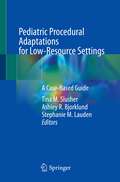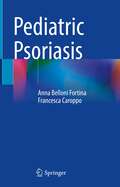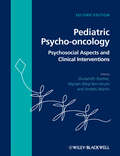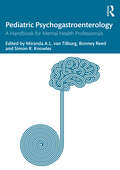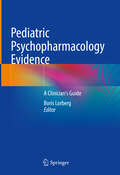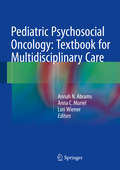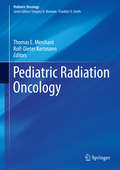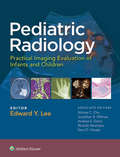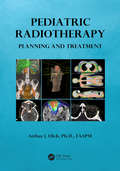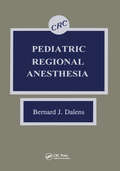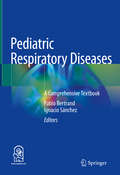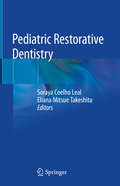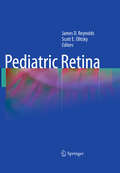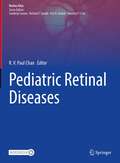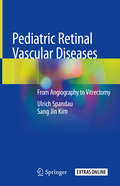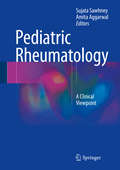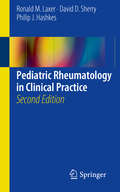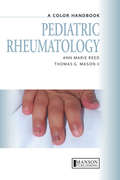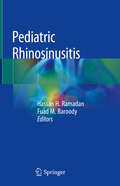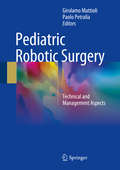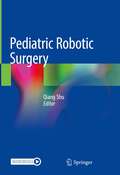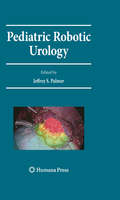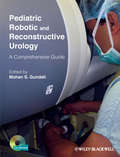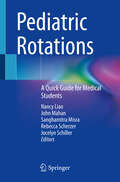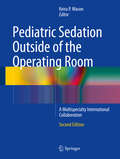- Table View
- List View
Pediatric Procedural Adaptations for Low-Resource Settings: A Case-Based Guide
by Tina M. Slusher Ashley R. Bjorklund Stephanie M. LaudenDespite global advancements in pediatric medicine, technologies which have become standard-of-care in high-resource settings are unavailable in low-and middle-income countries due to cost, availability, or challenges maintaining equipment. This book compiles evidence-based and expert clinical procedural adaptations in an approachable, case-based, step-by-step guide, aimed to provide educational support for healthcare providers practicing in resource-limited settings. This responds to both the high demand for this content and the importance of gathering experts across continents and pediatric disciplines. Each chapter provides both a theoretical framework and practical discussion of high-yield procedural adaptations. Leading international researchers and seasoned clinicians with expertise using these adaptations were selected by the editors as authors. Chapters include an example case with adaptation use and detailed instructions including supplies, indications, risks, and benefits. Content is grounded in current best practice recommendations and evidence-based research. Highlighted by the COVID-19 pandemic, a mature understanding of pathophysiology and device design/safety is required when providing care in low-resource settings or in crisis times. In-person instruction is not always feasible. Written and virtual platforms remain critical in disseminating high-yield, practical content. This book is not a substitute for appropriate procedural training, though is easily modified to meet the educational needs of diverse learner groups. It is a valuable resource for appropriately trained practitioners practicing in accordance with local guidelines. Knowledge and fluency with pediatric procedural adaptations is critical in efforts to reduce global inequities and pediatric morbidity/mortality in low-resource settings.
Pediatric Psoriasis
by Anna Belloni Fortina Francesca CaroppoThis book focuses on childhood psoriasis; it comprehensively discusses various concepts and topics related to this widespread auto-immune disease, including its pathogenesis, clinical aspects, the most recent and proven therapeutic approaches as well as the management of the psychological burden generated in younger patients. By highlighting the latest information on the pathogenic mechanisms, this unique book illustrates the great variety of clinical manifestations of this condition in pediatric patients, which are often very different from those in adults and later onset cases. It describes state-of-the-art therapeutic approaches and the advantages and limitations of latest treatment options available, and also presents all comorbidities of the disease in childhood, focusing on cardiovascular and metabolic disorders, as well as on the psychological impact of the disease in both children and adolescents. Including over 90 original full-color illustrations, this book raises dermatologists’ and pediatricians’ awareness of this disease, which is increasingly being diagnosed during childhood. It also provides practical tools for best management. This clear, concise guide is intended for dermatologists, pediatricians, clinicians and researchers as well as residents in dermatology and pediatrics, but will appeal to all readers wanting to update their understanding of psoriasis in childhood.
Pediatric Psycho-oncology
by Shulamith Kreitler Andrés Martin Myriam Weyl Ben-ArushLike the ground-breaking first edition, Pediatric Psycho-oncology, Second edition puts the child at the centre of medical and psychological care. It broadens the focus beyond treatment and cure to consider the quality of life of the child and their family. Written by an international group of pediatric oncologists and psychologists/psycho-oncologists brought together by an expert editorial team, it focuses on the real-life practical aspects of children undergoing treatment for cancer.This edition has been restructured and opens with a major section on Active treatment, which includes chapters addressing quality of life, pain, psychosocial aspects of treatment and interventions, art therapy and different fantasy-based techniques, palliative care, communication and education, as well as a new chapter on psychopharmacology. Shorter sections then discuss survivorship and care of the dying child, including a new chapter on bereavement. The final section comprises new chapters on ethical considerations and on addressing the emotional needs of children whose parents have cancer, as well as a case study on international collaboration. An appendix provides a comprehensive overview of tools for evaluation and assessment in pediatric psychooncology.This book is a highly practical resource that will be invaluable for all health care professionals looking after children and adolescents with cancer.
Pediatric Psychogastroenterology: A Handbook for Mental Health Professionals
by Miranda A.L. van Tilburg, Bonney Reed and Simon R. KnowlesBringing together international experts in psychological and behavioural treatments for pediatric gastrointestinal symptoms, this book provides detailed, evidence-based protocols targeting gastrointestinal distress and associated mental health concerns for patients and their families. The first consolidated resource on the topic, Pediatric Psychogastroenterology gives mental health professionals access to the most up to date clinical knowledge and practice. Taking a holistic approach, it guides the reader on the treatment and care of pediatric gastrointestinal patients, as well as how to work with and support children’s parents and families. The book is structured around symptom presentation and common challenges, enabling the reader to focus quickly on the area of need. Each chapter includes clinical pearls of wisdom and 62 developmentally appropriate worksheets for patients and their families to facilitate treatment, available for download. This practical, authoritative guide is an essential resource for mental health professionals who work directly with pediatric cohorts, as well as postgraduate students in health psychology, behavioral medicine, or social work.
Pediatric Psychopharmacology Evidence: A Clinician's Guide
by Boris LorbergThis book is a comprehensive guide to pediatric psychopharmacology, detailing medications used to treat a wide variety of childhood and adolescent mental illnesses. Childhood and adolescence represent critically important life stages in cognitive, social, and emotional development. Unfortunately, the prevalence of mental illness has been growing over the last several decades, especially among children. It is estimated that suicide is the second most common cause of death among adolescents and young adults in the United States. A crucial component of evidence-based mental health treatment of youth consists of careful, sophisticated, and compassionate medication treatment. This guide is divided into 18 chapters, with most covering the medications used to treat a specific disorder or group of disorders. Chapters comprehensively cover each medication’s history, FDA indication status and context, representation in the media, mechanism, extent of usage and research, and quality of evidence supporting its efficacy and safety. Chapters also cover approaches clinicians can use to discuss medications with patients—including alternative treatment options and integrating patient-level variables when choosing a medication. This book focuses on understanding patient and family perspectives on medication with suggested clinician responses to better communicate about prescription management. Chapters also include tables and figures, list resources and guidelines, and discuss controversies in the media. All prescribers to children and adolescents will find Pediatric Psychopharmacology Evidence to be a timely, comprehensive, and compassionate guide to the pharmacological treatment of young patients with mental illness.
Pediatric Psychosocial Oncology: Textbook for Multidisciplinary Care
by Annah N. Abrams Anna C. Muriel Lori WienerThis textbook walks clinicians through the psychosocial issues and challenges faced by children and adolescents with cancer and their families. Through a developmental lens, the text provides guidance and resources that will enable clinicians to understand the physical and emotional impact of the disease from diagnosis onwards, to work with families in distress, and to diagnose and treat a range of behavioral, psychological, and psychiatric issues. The book also addresses the burgeoning fields of social media, complementary therapies, palliative care, and survivorship. Among the variety of useful resources supplied are assessment tools, websites, and additional reading materials. The psychosocial issues that arise for children and their families during the course of treatment are an important yet often overlooked aspect of pediatric oncology care. The reader will find that Pediatric Psychosocial Oncology: Textbook for Multidisciplinary Care covers these issues at the forefront of clinical care in a direct and approachable way, integrating research literature with practical clinical guidance.
Pediatric Radiation Oncology (Pediatric Oncology Ser.)
by Thomas E. Merchant Rolf-Dieter KortmannThis book presents the most up-to-date and innovative information on the targeting and treatment of a wide range of childhood cancers by means of radiation therapy. Written by global experts in pediatric radiation oncology, it documents in detail the treatment regimens appropriate to each disease, highlighting the recent advances that promise to improve rates of survival and cure. The use of image-guided and intensity-modulated radiation therapy is clearly described, and careful attention is also devoted to the roles of proton therapy, stereotactic radiosurgery, stereotactic fractionated radiosurgery, and modulated arc radiotherapy. Separate chapters address localization and verification procedures and anesthesia; pediatric radiation oncology in the palliative care setting; and aspects that are especially relevant in low- and medium-income countries. Beyond clinical radiation oncology, relevant information is provided on radiation physics. The book concludes by examining future directions in the field.
Pediatric Radiology: Practical Imaging Evaluation Of Infants And Children
by Edward LeeYour accessible guide to the essentials of pediatric diagnostic imaging! Pediatric Radiology: Practical Imaging Evaluation of Infants and Children provides vital insights on how to diagnose both common and rare, congenital and acquired disorders in infants and children using the best imaging approaches available today. And, it does so in a highly concise, practical manner that makes this information easy to understand and apply. Contributions from a host of respected international authorities put the most relevant, expert information from around the world at your fingertips.
Pediatric Radiotherapy Planning and Treatment
by Arthur J. OlchBy becoming knowledgeable about optimal treatment methods designed specifically for childhood cancers, members of a radiotherapy team can help improve both pediatric cancer survival statistics and patients' quality of life. Pediatric Radiotherapy Planning and Treatment is the first single, focused resource available for health care providers to acc
Pediatric Regional Anesthesia
by BernardJ. DalensThis book provides a precise description of safe and reliable procedures for regional anesthesia in children. It covers the advantages and disadvantages, specific features related to the pediatric range of ages, and the practical importance of the described procedures. Written in two main parts, emphasis is placed on scientific basis and technical approach. It includes both anatomical and psychological aspects of pain, as well as detailed viewpoints of parents, children, surgeons, and anesthetists. This book is a must for all anesthesiologists and will be particularly useful to students of medicine and anesthesiology and nurses working with intensive care units.
Pediatric Respiratory Diseases: A Comprehensive Textbook
by Pablo Bertrand Ignacio SánchezThis is a comprehensive and authoritative textbook on pediatric pulmonology. Edited by Pablo Bertrand and Ignacio Sánchez, renowned academics and pediatricians from the Pontifical Catholic University of Chile, it encompasses five sections and 74 chapters, presenting and discussing the most important topics related to pediatric respiratory diseases. Written and presented in a simple and didactic format, it intends to ease learning and settlement of doubts in pediatric respiratory diseases. The reader is naturally introduced into the physiology, diagnosis, syndromes, diseases and the treatment associated with the respiratory pathologies affecting children. The chapters include algorithms for the treatment of various syndromes and updated treatment proposals grounded in evidence-based medicine for more than 50 pulmonary diseases. Pediatric Respiratory Diseases – A Comprehensive Textbook is an essential reference for the proper clinical approach to respiratory diseases in children. It is intended for all interns, residents and fellows with interest in pediatric pulmonary medicine, as well as practicing physicians, general practitioners, pediatricians and pulmonologists who face pediatric respiratory disorders in daily clinical practice.
Pediatric Restorative Dentistry
by Soraya Coelho Leal Eliana Mitsue TakeshitaThis book describes and discusses the different restorative options for managing carious lesions in children with primary and mixed dentition. The aim is to provide practitioners with thorough, up-to-date information that will improve their clinical practice. The opening chapters present a comprehensive overview regarding diagnosis of carious lesions, risk assessment, child behavior and development, and behavioral management. The importance of oral health promotion and prevention in controlling lesion progression and maintaining oral health is reviewed. The impact of various factors on clinician decision making is then explained in detail, examples including the type of dentition (primary versus permanent), the clinical and radiographic aspect of the dentine carious lesion (noncavitated or cavitated), and whether the lesion is associated with a developmental defect. Guidance is provided on selection of nonoperative versus operative interventions, and the restorative materials most frequently used in pediatric dentistry are fully described, highlighting their advantages and disadvantages. Readers will also find an informative series of cases, with explanation of the choices in terms of materials and approach.
Pediatric Retina
by James D. Reynolds Scott E. OlitskyPediatric retinal diseases are not simply retinal diseases that occur in children; rather, they are unique disorders that often are not found in adults. This textbook of the pediatric retina offers in-depth guidance on congenital and acquired diseases of the retina in the pediatric population. It is organized according to disease onset and timing, as well as anatomy. All chapters are written by leading authorities in the field from both the pediatric and the retinal perspective. A multidisciplinary approach to the topic is adopted, and critical information is included on disease classification and diagnosis, pathophysiology, genetics, complications, and prognosis. Pediatric Retina will be a useful source of information for pediatric ophthalmologists, retina specialists, and other eye care providers who care for children.
Pediatric Retinal Diseases (Retina Atlas)
by R. V. Paul ChanThis volume on pediatric retina covers all aspects of pediatric retinal diseases as their understanding, diagnosis and management is still under evolution and a challenging task. Newer diagnostic and surgical techniques are being developed and are being adapted for better visual outcome in pediatric cases. It comprises of 10 chapters describing the medical and surgical aspects. The text and figures have been provided in a lucid manner to enhance the understanding of the reader. This volume covers OCT angiography for pediatric retinal disease, clinical spectrum of retinopathy of prematurity, which has become an ever increasing burden of disease for the society and needs special attention, anti-VEGF for retinopathy of prematurity, surgical management of retinopathy of prematurity, retinopathy of prematurity: atypical aspects, Coats’ disease, pediatric retinal inflammatory disorders, congenital X-linked retinoschisis, familial exudative vitreoretinopathy, hematologic disorders: leukemia, hyperviscosity, anemia. It provides descriptions of these disease accompanied by numerous helpful images to highlight these conditions. This atlas will assist the vitreoretinal specialists, general ophthalmologists, retina fellows and post graduate students in successfully identifying the key features of these challenging pediatric vitreoretinopathies. Pediatric Retinal Diseases is one of the nine volumes of the series Retina Atlas. This series provides global perspective on vitreoretinal diseases, covering imaging basics, retinal vascular disease, ocular inflammatory disease, retinal degeneration, surgical retina, ocular oncology, pediatric retina and trauma. Retina Atlas is spread over 9 volumes and about 100 chapters, covering validated and comprehensive information on retinal disorders.
Pediatric Retinal Vascular Diseases: From Angiography to Vitrectomy
by Ulrich Spandau Sang Jin KimThis book provides comprehensive and up-to-date information on diagnosis, medical and surgical treatments for pediatric retinal vascular conditions, which are leading causes of childhood blindness throughout the world. Experienced ophthalmologists in the field discuss basic knowledge about these diseases and practical aspects of management such as exam under anesthesia, diagnostic approaches including spectral-domain hand-held optical coherence tomography (OCT) and OCT angiography. The reader will learn about the recent advances in medical and surgical treatments for pediatric retinal vascular diseases. The surgical treatments, anti-VEGF injections, laser photocoagulation and lens sparing vitrectomy are explained step-by-step and can be observed in several videos.Both the general ophthalmologist who cares for children with retinal diseases and the specialist (pediatric ophthalmologists and vitreoretinal surgeon) will find this book to be an informative resource in providing best care for children with pediatric retinal vascular conditions.
Pediatric Rheumatology
by Sujata Sawhney Amita AggarwalThis book on rheumatology in children is intended to be a handy tool for all professionals interested in this field. It is divided into five sections: General considerations, arthritic problems, connective tissue diseases, systemic vasculitides and finally a section that covers miscellaneous issues such as Immunodeficiencies, bone heath and uveitis. The book has an easy format with each chapter having one or more clinicalvignettes at the start of the chapter. In addition each chapter outlines the learning objectives and key take home messages. At the end of each section a collection of cases to highlight important issues in the clinic are included. The colorful charts, pictures and tables make reading this book an easy task. The authors are leading experts in their fields working at best practices centers globally to provide the reader with state-of-the-art information.
Pediatric Rheumatology in Clinical Practice
by Ronald M. Laxer David D. Sherry Philip J. HashkesThis second edition is primarily for trainees and junior pediatric residents in adult rheumatology who will be seeing pediatric patients with rheumatic diseases. The short chapters have clear tables and many clinical photos to demonstrate key features of diseases and allow the reader to be well informed when seeing patients with rheumatic diseases. This book also allows the readers to develop and approach the field and develop differential diagnoses.
Pediatric Rheumatology: A Color Handbook (Medical Color Handbook Ser.)
by Thomas Mason Anne Marie ReedPhysicians caring for children with rheumatic disease need a varied and highly developed set of clinical skills, including general pediatrics, immunology, musculoskeletal medicine and the management of chronic diseases.With these requirements in mind, the authors of this concise handbook emphasize the most frequently recognized symptom complexes in
Pediatric Rhinosinusitis
by Hassan H. Ramadan Fuad M. BaroodyThe volume provides a comprehensive, up-to-date and exhaustive review of pediatric rhinosinusitis for clinicians, surgeons, researchers, advanced care providers as well as emergency personnel. It provides information regarding pathophysiology of sinusitis, and how to distinguish between the differential diagnoses of a child with a runny nose. It also utilizes current evidence-based guidelines and consensus statements to clarify this condition to the physician and discusses available medical and surgical treatment. Authored by clinicians with long-time expertise with this disease, Pediatric Rhinosinusitis also reviews definitions, burden of disease, microbiology and pathophysiology of the disease; role of adenoids, allergy and asthma as co-morbid conditions; comprehensive medical management; and the role of topical treatment. It also covers the latest advancements in new treatments such as drug-eluting stents; comprehensive surgical management; and complications of rhinosinusitis. It will be a valuable resource for otolaryngologists, surgeons, residents, medical students and advanced practice providers for years to come.
Pediatric Robotic Surgery
by Girolamo Mattioli Paolo PetraliaThis book presents the state of the art across the entire field of pediatric robotic surgery, including thoracic, abdominal, oncologic, gynecologic, and urologic procedures. Indications for each type of robotic surgery are clearly set out and technical aspects are described in detail, illustrating the patient's position and explaining the robotic assessment and the optimal use of robotic instruments. Anesthetic issues and the management of robotic complications are discussed, and managerial aspects are also considered, with provision of helpful suggestions on how to approach robotic surgery in each pediatric department. For surgeons who wish to start using the pediatric robotic approach, simple illustrations of robotic assessment and principles of robotic surgery are included. Pediatric robotic surgery has undergone significant development in recent years, and the technology is now applied to a variety of pediatric diseases beyond urology. This book has been written by a group of world-renowned pioneers of pediatric robotic surgery and will appeal to pediatric surgeons of all disciplines, to residents, and to hospital general managers and medical directors.
Pediatric Robotic Surgery
by Qiang ShuPaediatric robotic surgery has been rapidly developed in recent years. This book presents comprehensive and advanced knowledge of different types of paediatric robotic surgery including thoracic, oncologic, abdominal and urologic surgeries. Each chapter is with the same layout as the introduction, indications and contraindications, preoperative preparation, detailed surgical approaches, and post-operative complication management as well as comparison with conventional surgery together with case presentations and video recordings in the end. It is a key reference book for paediatric surgeons and residents who would like to learn and to perform paediatric robotic surgery, and also for hospital general managers for how to establish paediatric robotic surgery settings.
Pediatric Robotic Urology
by Jeffrey S. PalmerRobotic technology has paved the way for new opportunities in pediatric urologic surgery. Where once laparoscopy was restricted to urological conditions in children such as undescended testicles and ambiguous genitalia, robotic techniques are now enabling the completion of greatly needed, more involved procedures. Written by highly respected surgeons, Pediatric Robotic Urology provides a state-of-the-art, comprehensive overview of the precise surgical techniques that are changing the practice of pediatric urologic surgery. Divided in two sections and covering both introductory topics and advanced surgical techniques, Pediatric Robotic Urology also includes myriad illustrations and photographs of intraoperative procedures. Developed for accessible reading, this invaluable title is a concise, yet broad reference that is certain to be of significant value to urologists, surgeons, and all health care providers who care for pediatric urologic patients.
Pediatric Robotic and Reconstructive Urology
by Mohan S. GundetiThe most exciting contemporary developments in pediatric urology are now demonstrated in text and on video in this innovative, practical guide. A practical text for experienced practitioners and trainees alike, this comprehensive resource introduces the new techniques and surgical planning required to begin mastery of robotic approaches. From a renowned editor and contributors, this book features 130 illustrations and comes with a companion website containing 30 high-quality surgical videos demonstrating each technique.
Pediatric Rotations: A Quick Guide for Medical Students
by Sanghamitra Misra Nancy Liao John Mahan Rebecca Scherzer Jocelyn SchillerPediatric rotations are a crucial part of medical education, yet didactic curricula often do not spend much time on pediatric-specific skills. Learners often enter the pediatric clinical setting with little preparation and orientation. The care of children is nuanced and specialized and requires a different approach than adult medicine. This text serves as a valuable resource for students on pediatric clinical rotations and for advanced practitioners entering pediatric clinical practice without much prior experience. This high yield book covers the fundamental knowledge and skills required for pediatric care, including the physical, emotional, and social development of children, and the diagnosis and management of common pediatric conditions, with emphasizes on a patient-centered approach. Clinical pearls and application exercises embedded within each chapter help students prepare for real-life clinical scenarios and written examinations. The section on communication with the medical team reviews how to present pediatric patients on family-centered rounds, how to write succinct and useful notes, how to eloquently request a consult, and safely handoff a patient. The book also features practical tips on inter-professional communication, breaking bad news, and strategies to enhance learning and achieve success while working within a pediatric care team. Finally, a portion of the book is devoted to the considerations specific to the clinical settings where most learners rotate. Written by experts in the field, Pediatric Rotations provides a detailed overview of skills required to be successful on pediatric wards and in pediatric clinics while also including the most up to date scientific and clinical information.
Pediatric Sedation Outside of the Operating Room
by Keira P. MasonThis comprehensive guide provides tips and instruction for the entire range of specialists that utilize pediatric sedation. Each specialty receives tailored coverage that focuses on its unique patient population, challenges, potential solutions, and sedation techniques. Each chapter is written by a leading specialist in the field. A comprehensive spectrum of pediatric sedation will be covered, which will be of interest to oncologists, pediatricians, hospitalists, intensivists, radiologists, emergency medicine specialists, anesthesiologists, nurses, dentists, and gastroenterologists. Background chapters cover pharmacology as well as pediatric anatomy, with special focus on the airway and respiratory mechanics. The future of pediatric sedation is also reviewed as well as the cutting-edge research that is being done in the field.
